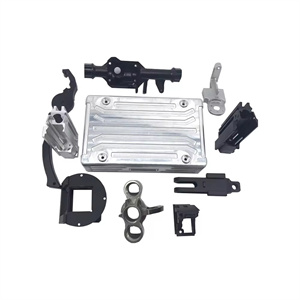CNC milling is widely used in the transportation industry, and its high precision, flexibility, and diverse processing capabilities make it an indispensable and important process in the industry. CNC Milling uses computer-controlled milling machines for three-dimensional machining, which can accurately remove materials and manufacture complex shapes and high-precision parts. In the transportation industry, CNC Milling is widely used in multiple fields such as automobiles, rail transit, aerospace, etc., to meet high requirements for component accuracy, strength, and complexity.
Specific Applications of CNC Milling
1. Automotive industry
a. Engine components
Key components such as engine cylinder block, cylinder head, and crankcase are often machined using CNC Milling. These components need to withstand high temperature, high pressure, and high-speed operating environments, thus requiring extremely high precision and surface quality. CNC Milling can ensure the dimensional and shape accuracy of these components, improving the performance and reliability of the engine.
Precision machined engine components such as crankshafts and connecting rods can reduce friction and wear, improve engine efficiency and service life. It is estimated that the accuracy of engine components manufactured through CNC Milling technology can reach the micrometer level, providing strong guarantees for the high-performance performance of the engine.
b. Body and chassis structure
The structural components of the vehicle body, such as the frame crossbeam and longitudinal beam, can be ensured to have strength and stiffness through CNC milling processing, improving the load-bearing capacity and safety of the vehicle body. At the same time, CNC Milling can also process complex body surfaces and lines, improving the appearance design and aerodynamic performance of vehicles.
The suspension system components, steering system components, etc. in the chassis system are often manufactured using CNC Milling technology. The high-precision processing of these components helps to improve the handling and comfort of the vehicle, ensuring stable driving in complex road conditions.
c. Electronic and Control Systems
With the improvement of automotive electronics, more and more electronic control system components such as sensors and actuators are also processed using CNC Milling technology. These components require precise dimensions and shapes to ensure their proper functioning, and CNC Milling can meet this requirement.
2. Rail transit
a. EMU and subway vehicles
CNC Milling technology is widely used in the manufacturing of key components such as bogies, wheels, and axle boxes. These components need to withstand enormous loads and high-speed operating environments, thus requiring extremely high precision and strength. CNC Milling can ensure the precise machining and high-quality manufacturing of these components, improving the safety and reliability of rail transit vehicles.
For example, in the manufacturing of high-speed train wheels, CNC Milling technology can achieve precise machining of key parts such as wheel tread and rim, ensuring good contact and stable operation between the wheels and the track.
b. Bearings and transmission devices
Bearings, gears, and other transmission devices in rail transit vehicles are often manufactured using CNC Milling technology. The high-precision machining of these parts helps to reduce friction and wear, improve transmission efficiency and service life. CNC Milling can ensure the dimensional accuracy and surface quality of these parts, meeting the strict requirements of rail transit vehicles for transmission systems.
